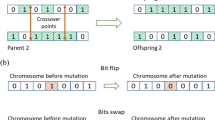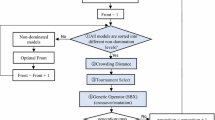Abstract
We embedded the genetic algorithm (GA) into the inner loop of the simulated annealing (SA) with a special designed junction. This strategy can boost the tunability of the searching process by providing two scales of regulation in seismic inversion problems. Moreover, a quantified uncertainty of the inversion result can be given when we put this strategy under Bayesian framework. Real data tests are conducted to support the theoretical calculation. Based on the conventional sparse spike inversion results, as a part of the prior information, our proposed method presents a superior quality and convincible uncertainty description.









Similar content being viewed by others
References
Bayes M (1763) Price, An essay towards solving a problem in the doctrine of chances. Philos Trans R Soc Lond 53:370–418
Bezada MJ, Zelt CA (2011) Gravity inversion using seismically derived crustal density models and genetic algorithms: an application to the Caribbean-South American Plate boundary. Geophys J Int 185:577–592
Borges P, Eid T, Bergseng E (2014) Applying simulated annealing using different methods for the neighborhood search in forest planning problems. Eur J Oper Res 233:700–710
Brusco MJ (2014) A comparison of simulated annealing algorithms for variable selection in principal component analysis and discriminant analysis. Computational Statistics and Data Analysis 77:38–53
Buland A, More H (2003) Bayesian linearized AVO inversion. GEOPHYSICS 68(1):185–198
Černý V (1985) Thermodynamical approach to the traveling salesman problem: An efficient simulation algorithm. J Optim Theory Appl 45:41–51
Cordua KS, Hansen TM, Mosegaard K (2012) Monte Carlo full-waveform inversion of cross-hole GPR data using multiple-point geostatistical a priori information. GEOPHYSICS 77(2):9–31
Davis L (1991) Handbook of Genetic Algorithms. Van Nostrand Reinhold, New York
De Voogd N, Rooijen H (1983) Thin-layer response and spectral bandwidth. Geophysics 48:12–18
Green PL (2015) Bayesian system identification of a nonlinear dynamical system using a novel variant of simulated annealing. Mech Syst Signal Process 53:133–146
Hansen TM, Cordua KS (2012) Inverse problems with non-trivial priors: efficient solution through sequential Gibbs sampling. Comput Geosci 16:593–611
Holmes C, Mallick BK (1998) Bayesian radial basis functions of variable dimension. Neural Comput 10:1217–1235
Hong T, Sen MK (2009) A new MCMC algorithm for seismic waveform inversion and corresponding uncertainty analysis. Geophys J Int 177:14–32
Kirkpatrick S, Gelatt CD, Vecchi MP (1983) Optimization by simulated annealing. Science 220:671–680
Looms MC, Hansen TM, Cordua KS (2010) Geostatistical inference using crosshole ground-penetrating radar. GEOPHYSICS 75(6):29–41
Martin J, Wilcox LC, Burstedde C (2012) A stochastic newton MCMC method for large-scale statistical inverse problems with application to seismic inversion. SIAM J Sci Comput 34(3):1460–1487
Oh S-H, Kwon B-D (2001) Geostatistical approach to Bayesian inversion of geophysical data: Markov chain Monte Carlo method. Earth Planets and Space 53:777–791
Pérez DO, Velis DR, Sacchi M (2017) D, Three-term inversion of prestack seismic data using a weighted l 2, 1 mixed norm, Geophys Prospect, pp. 1–19
Sanchez-Ranirez JA, Wolf D, Torres-Verdin C (2010) Synthetic and field examples of the Bayesian stochastic inversion of gamma-ray, density, and resistivity logs, Annual Logging Symposium, vol. 51
Tarantola (1987) Inverse problem theory: methods for data fitting and model parameter estimation. Elsevier Science Publishers B.V, Amsterdam
Funding
This research was co-sponsored by the Open Fund (NO. GDL1609) of Key Laboratory of Geo-detection (China University of Geosciences, Beijing), Ministry of Education, excellent mentors fund (NO. 2-9-2017-438), and Ministry of Education, national science and technology major project (2016ZX05003-003).
Author information
Authors and Affiliations
Corresponding author
Additional information
Responsible Editor: Abdullah M. Al-Amri
Rights and permissions
About this article
Cite this article
Hu, Rq., Wang, Yc., Gao, Y. et al. A Bayesian approach to seismic inversion based on GASA algorithm. Arab J Geosci 13, 6 (2020). https://doi.org/10.1007/s12517-019-4789-y
Received:
Accepted:
Published:
DOI: https://doi.org/10.1007/s12517-019-4789-y




